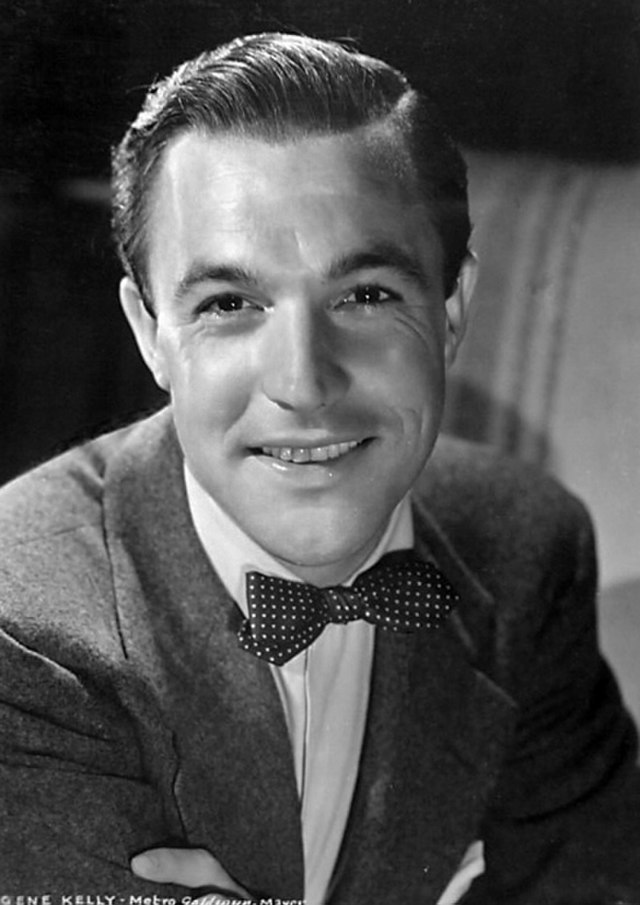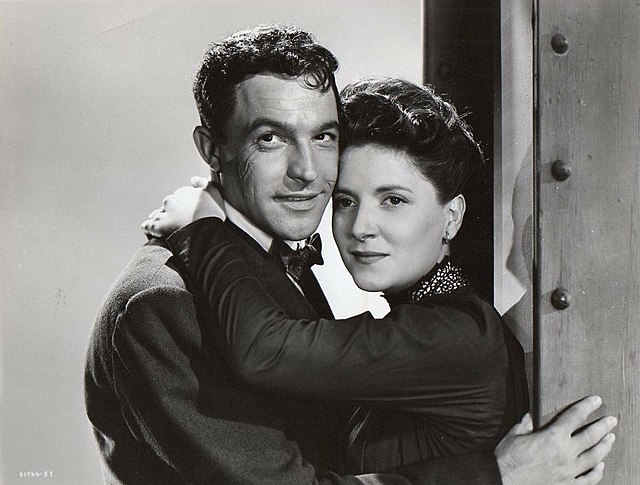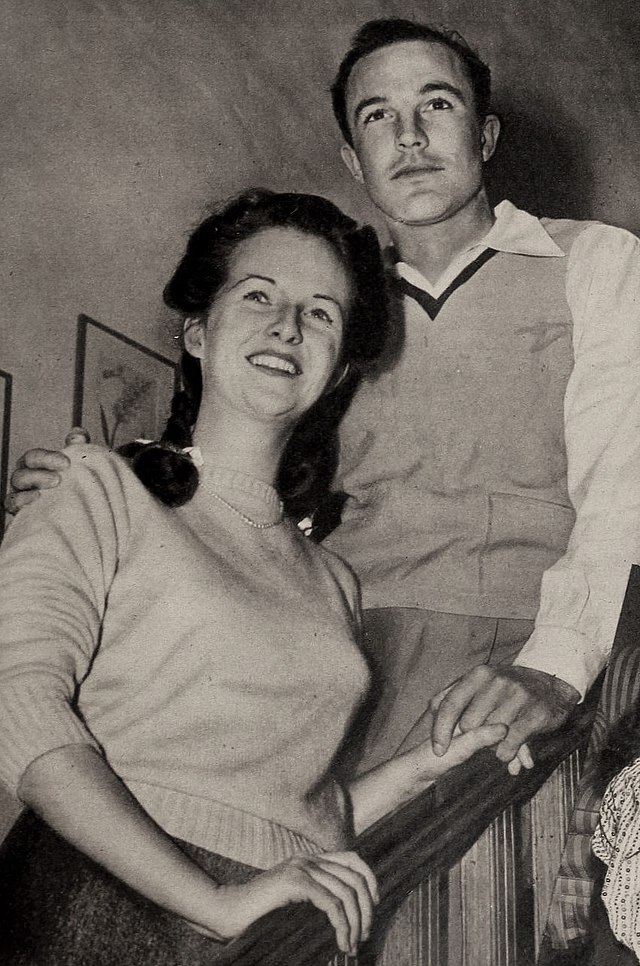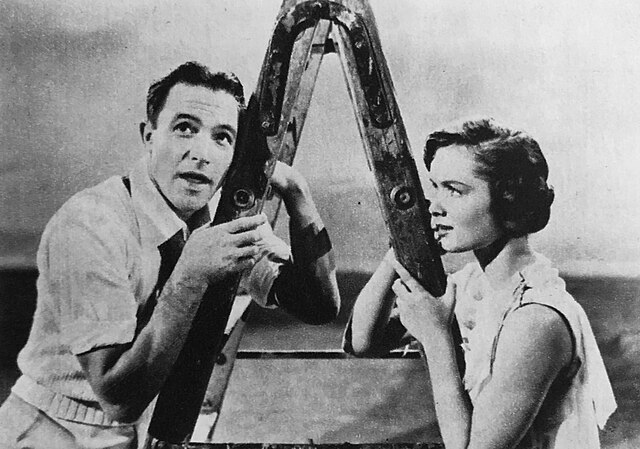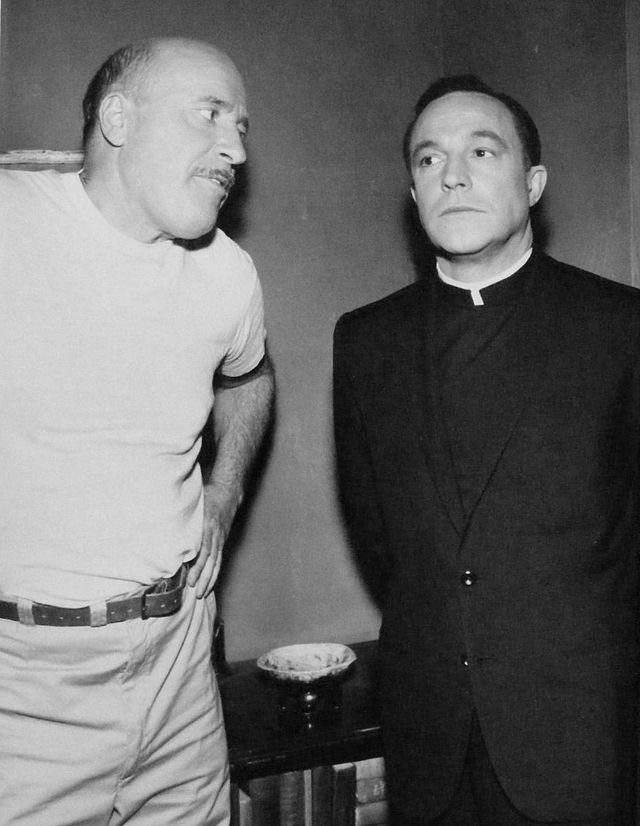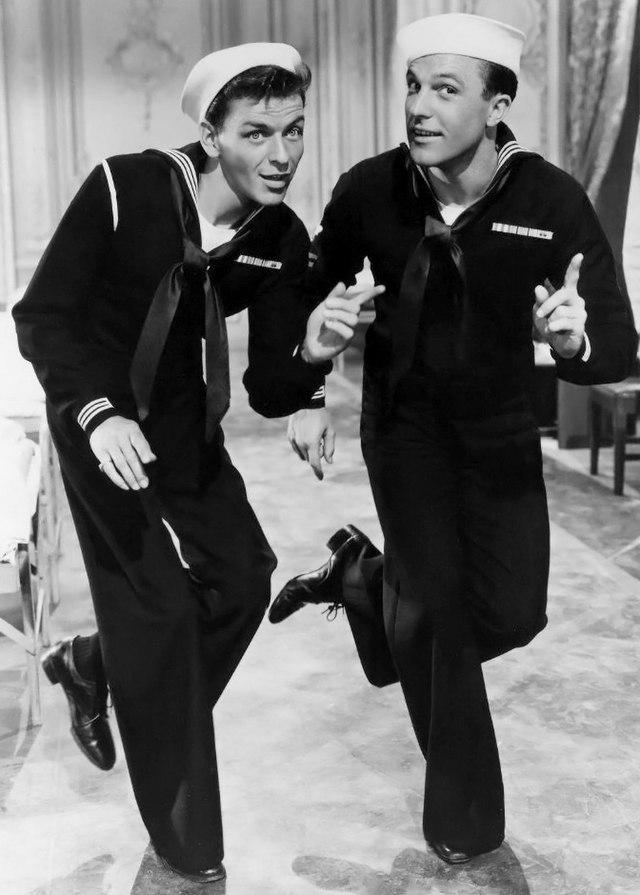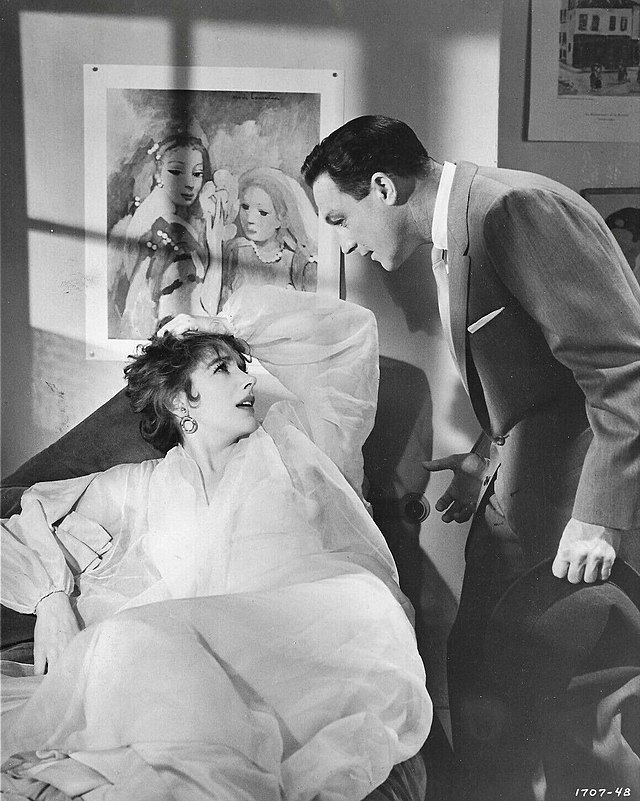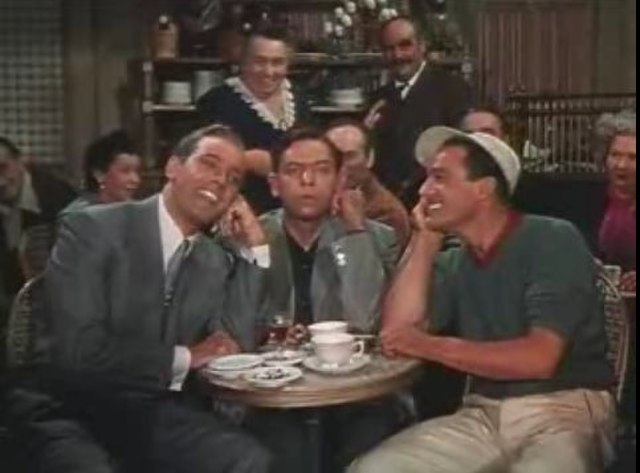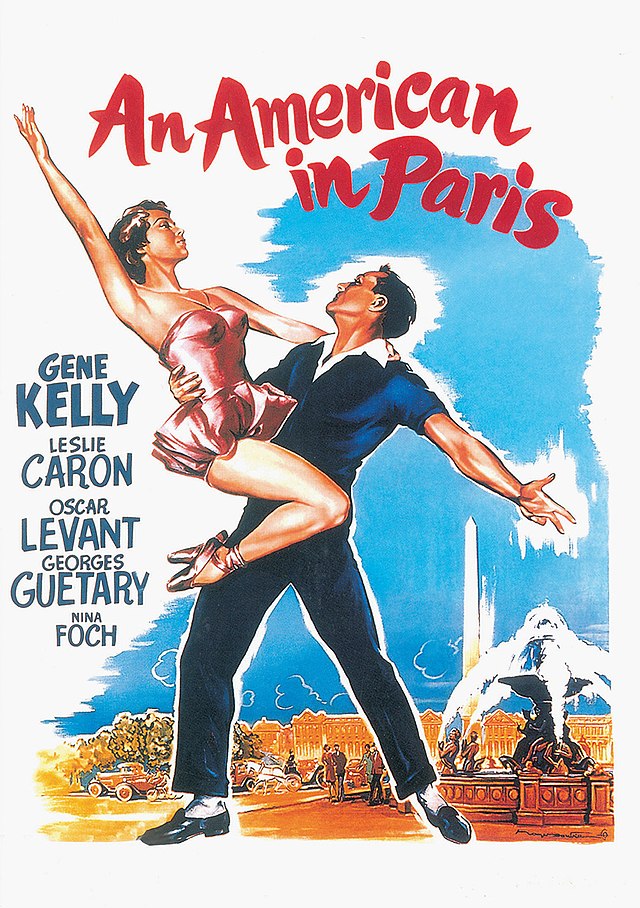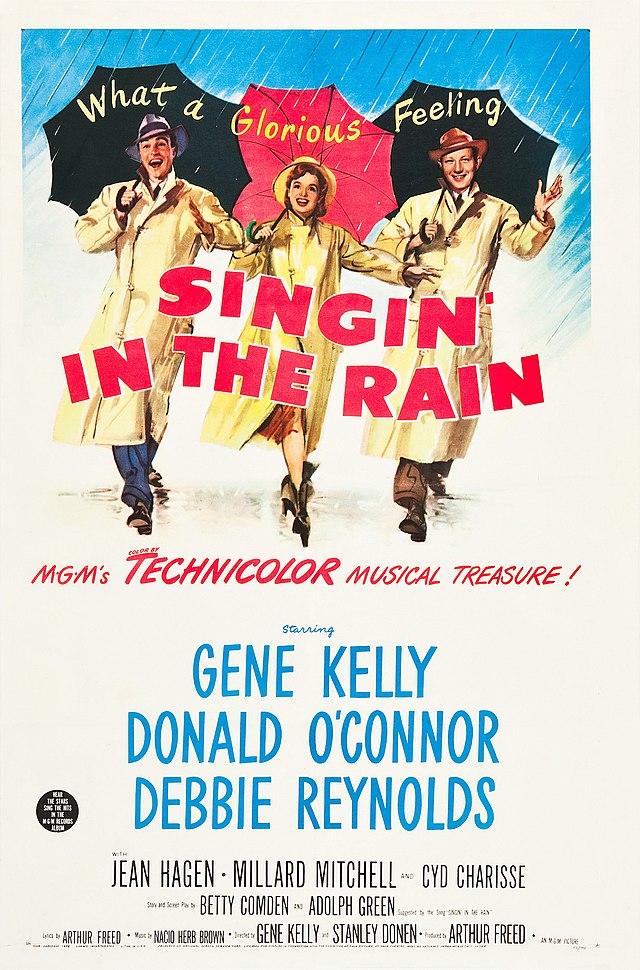Gene Kelly
back| Full Name | Eugene Curran Kelly |
| Stage Name | Gene Kelly |
| Born | August 23, 1912 |
| Birthplace | Pittsburgh, Pennsylvania, USA |
| Died | February 2, 1996 |
| Buried | Cremated, ashes scattered in the Pacific Ocean |
| Married to | Betsy Blair (m. 1941; div. 1957) - Jeanne Coyne (m. 1960; died 1973) - Patricia Ward Kelly (m. 1990; until his death in 1996) |
| Children | Kerry Kelly (with Betsy Blair) - Timothy Kelly (with Jeanne Coyne) - Bridget Kelly (with Jeanne Coyne) |
| Notable films | Singin' in the Rain (1952) - An American in Paris (1951) - On the Town (1949) - The Pirate (1948) - Cover Girl (1944) - Brigadoon (1954) |
Gene Kelly
The Working Man's Dancer
Gene Kelly was a groundbreaking actor, dancer, choreographer, and director who revolutionized the movie musical genre. Known for his energetic and athletic dancing style, he made musicals more accessible to the everyday person with his relatable charm.
After starting his career on Broadway, he transitioned to Hollywood where he became a leading figure at MGM during its golden era. He was especially noted for his innovative use of dance on film, blending ballet, tap, and modern dance with narrative elements.
Kelly’s most iconic performance came in Singin' in the Rain, where his solo dance sequence during the titular song became a hallmark of cinema history.
Related
Gene Kelly (1912 – 1996)
Biography and Movie Career
Eugene Curran Kelly, famously known as Gene Kelly, was born on August 23, 1912, in Pittsburgh, Pennsylvania, to a middle-class Irish-American family. He was the third of five children born to James Patrick Joseph Kelly, a phonograph salesman, and Harriet Catherine Curran, who was the driving force behind his initial exposure to dance. His mother believed that dancing would help her children develop physical grace, and she enrolled Gene and his siblings in dance classes at a young age. Gene, however, initially showed little interest, preferring sports, particularly hockey and gymnastics.
Growing up in Pittsburgh’s East Liberty neighborhood, Gene's ambition was to become a professional athlete, but during the Great Depression, the family's financial difficulties altered his plans. To support themselves, the Kelly family opened a dance school, the Gene Kelly Studio of the Dance, where Gene began to teach dance alongside his brother Fred. It was during these years that Kelly discovered his true passion for dance and performing. His early exposure to the struggles of everyday Americans would later influence the working-class, relatable personas he often portrayed in his films.
Education and Entry into Show Business
Gene Kelly attended the University of Pittsburgh, where he majored in economics. Though initially pursuing a more conventional career path, he remained drawn to dance and performing arts. His involvement in the university’s Cap and Gown Club, a musical theater group, allowed him to explore acting and choreography. After graduating in 1933, Kelly briefly attended law school but dropped out to pursue a career in entertainment.
Kelly soon found his way to Broadway, where he made his debut as a chorus boy in Leave It to Me! in 1938. His breakthrough role came in 1940, when he was cast as the lead in Pal Joey, a show that earned him widespread acclaim. His strong, athletic dancing style—combined with a natural charm—quickly made him a standout. His success on stage eventually caught the attention of Hollywood, and by the early 1940s, Kelly had signed a contract with Metro-Goldwyn-Mayer (MGM), one of the most prominent film studios at the time.
Rise to Stardom in Hollywood
Gene Kelly’s Hollywood career took off in 1942 with his film debut in For Me and My Gal, where he starred opposite Judy Garland. The film was well received, and Kelly's combination of athleticism, charm, and boy-next-door appeal quickly made him a leading figure in Hollywood musicals.
Kelly's real breakthrough came with Cover Girl (1944), where he co-starred with Rita Hayworth. He choreographed one of the most memorable scenes in the film, a solo dance sequence where he danced with his own reflection, using special effects that were cutting-edge for the time. This innovation showed Hollywood that Kelly was not just a talented dancer, but also a visionary choreographer.
In 1945, Kelly starred in Anchors Aweigh alongside Frank Sinatra. One of the film’s most iconic moments was his dance routine with Jerry, a cartoon mouse from Tom and Jerry. This blend of live-action and animation was revolutionary, further solidifying Kelly's reputation for pushing the boundaries of dance on film.
His career reached its zenith in the early 1950s. In 1951, Kelly starred in An American in Paris, which won the Academy Award for Best Picture. His ballet sequence at the film's climax was both an artistic and technical triumph, running 17 minutes long and featuring a dazzling array of dance styles. Kelly's performance in the film earned him an honorary Academy Award for his “versatility as an actor, singer, director, and dancer, and specifically for his brilliant achievements in the art of choreography on film.”
Perhaps his most iconic film, Singin’ in the Rain (1952), followed soon after. Kelly not only starred in the film but co-directed it with Stanley Donen. The film, which featured Kelly's unforgettable dance number to the title song, is often regarded as one of the greatest musicals ever made. Kelly’s performance in the rain, twirling an umbrella while splashing through puddles, became a symbol of joy, creative freedom, and mastery of dance.
Personal Life and Marriages
Gene Kelly's personal life was marked by three marriages. His first marriage was to actress Betsy Blair in 1941. They had one daughter, Kerry Kelly, born in 1942. Blair, an outspoken political activist, faced difficulties during the McCarthy era when Hollywood was gripped by anti-communist sentiment. Despite their strong bond, the couple eventually divorced in 1957.
Kelly married his second wife, Jeanne Coyne, in 1960. Jeanne had been a dancer and choreographer who worked with Kelly on several of his films. Together, they had two children: Timothy Kelly and Bridget Kelly. Tragically, Jeanne passed away in 1973 from leukemia.
Kelly found love again later in life with Patricia Ward, whom he married in 1990. Patricia was a writer and journalist, and though there was a 47-year age difference between them, the couple remained devoted to one another until Kelly’s death.
Passions Beyond Acting
Gene Kelly was not only passionate about dance and film but was deeply involved in the creative process behind the camera. He was a skilled choreographer and director, co-directing films like On the Town (1949) and Singin’ in the Rain (1952). He constantly sought to innovate and bring new perspectives to dance on film, pushing the boundaries of what could be achieved in musicals.
Outside of work, Kelly was a dedicated father and a man of many interests. He was an advocate for physical fitness and was involved in numerous charitable causes. He also loved sports, particularly ice hockey, and was known for his intellect and love of learning. Kelly spoke French fluently and was known to read extensively on a variety of subjects.
Final Years and Death
In the final years of his life, Kelly continued to receive accolades for his contributions to film and dance. However, his later years were marked by health challenges. In 1994, he suffered a stroke that left him partially incapacitated. A second stroke in 1995 further diminished his health, and on February 2, 1996, Gene Kelly passed away at the age of 83 at his home in Beverly Hills, California. The official cause of death was complications from the two strokes.
True to his wishes, Kelly was cremated and his ashes were scattered at sea in the Pacific Ocean. His death marked the end of an era, but his legacy in American cinema and dance remains timeless.
Legacy
Gene Kelly left an indelible mark on both dance and film. His work bridged the gap between highbrow ballet and accessible, everyday dance, making movement a universal language of joy and emotion on screen. His films continue to inspire dancers, choreographers, and filmmakers around the world, ensuring that his influence on popular culture endures.
Singin' in the Rain Performance by Gene Kelly
The Mult-Faceted Gene Kelly
Gene Kelly’s acting style was as dynamic, multi-faceted, and revolutionary as his dancing. As both an actor and dancer, Kelly was known for his charm, physicality, and naturalness on screen, setting him apart from his contemporaries.
The "Everyman" Persona
One of the most distinctive aspects of Kelly’s acting style was his embodiment of the "everyman." Unlike the refined elegance of Fred Astaire, Kelly portrayed a more grounded, relatable character. He often played working-class heroes—sailors, soldiers, athletes, and artists—men who were down-to-earth, approachable, and familiar to the average American. This helped audiences identify with his characters and made Kelly feel like someone they could encounter in real life.
In films like On the Town and Singin’ in the Rain, Kelly’s characters were infused with optimism, energy, and warmth. His smile and easygoing demeanor made him an appealing presence on screen, while his characters often exuded a sense of adventure and hope. This "everyman" persona was central to the success of his films, as it allowed Kelly to break away from the more formal, polished image of previous movie stars and create a style that was more accessible and authentic.
Physical Expressiveness and Athleticism
Kelly’s background in dance is integral to understanding his acting style. His movement was not confined to musical numbers—his entire physicality informed how he inhabited a role. Kelly’s acting was remarkably fluid and physical, often using his body to express emotions and convey character development. This sense of physical expressiveness brought his characters to life in a way that made them seem almost kinetic, even in non-dancing scenes.
In An American in Paris and Brigadoon, for instance, Kelly’s physicality as an actor extended beyond the dance numbers. He didn’t simply act through dialogue; he moved with a purpose, using gestures, posture, and even his walk to convey the essence of a scene. He blurred the line between dancer and actor, creating a seamless blend of both. His characters’ actions always felt deeply tied to their emotions, making every movement count.
Kelly’s acting style also incorporated a sense of athleticism. He wasn’t a graceful, gliding performer like Astaire, but rather, a more powerful, muscular presence on screen. His athletic build and confident, dynamic way of moving gave his characters strength and vitality. In films like Anchors Aweigh and Cover Girl, Kelly often displayed this athleticism through jumps, flips, and intricate footwork, lending an air of energy and vibrancy to his performances.
Naturalism and Unaffected Charm
Gene Kelly brought a naturalistic, unpretentious quality to his acting. He was never overly theatrical or showy in his performances, preferring instead a more understated, genuine approach. His dialogue delivery felt conversational and real, especially in his comedic roles, where his quick wit and impeccable timing shone.
In Singin’ in the Rain, his character, Don Lockwood, is effortlessly charming without being over the top. Kelly’s natural charisma comes across in how he interacts with other characters, particularly in romantic and comedic scenes. His chemistry with co-stars like Debbie Reynolds, Judy Garland, and Frank Sinatra felt organic, a result of his easy-going and unforced acting style. He rarely seemed like he was "acting," instead making every scene seem like an authentic slice of life.
His lack of pretension made him particularly effective in romantic roles. Whether playing opposite a star like Rita Hayworth in Cover Girl or Leslie Caron in An American in Paris, Kelly’s approach to romance was refreshingly honest and down-to-earth. His characters were not grandiose, poetic lovers but approachable, sincere men who expressed their affection in more grounded, human ways.
Innovative Use of Dance in Acting
What truly set Kelly apart from many of his contemporaries was how he integrated dance into his acting. For Kelly, dance wasn’t simply an interlude within a film—it was a form of storytelling and character development. He used dance to convey emotions that went beyond what words could express, and his choreography was often designed to reflect his character’s state of mind or inner journey.
In Singin’ in the Rain, his famous dance sequence during the title song wasn’t just a display of technical prowess; it was an emotional release for his character, Don Lockwood, who had just realized he was in love. Kelly's acting in that scene combined joy, playfulness, and freedom, using dance as an extension of the character’s emotional arc. This type of integration made his performances feel more complete, as though dance and acting were two sides of the same coin.
His ability to transition seamlessly between acting and dancing without missing a beat was part of his unique brilliance. Kelly’s dances were often structured around everyday activities—whether it was dancing with a broom in Summer Stock or sliding across a wet street in Singin' in the Rain. His characters didn't stop being themselves when they danced; instead, they used dance to express what they were feeling in the most natural way possible.
Humor and Self-Awareness
Kelly’s performances often carried a sense of humor, and his acting was frequently infused with lightness and self-awareness. He understood the comedic value of timing and physical comedy, incorporating elements of slapstick into his films without undermining his characters’ sincerity. In Take Me Out to the Ball Game and On the Town, Kelly’s comedic timing and his willingness to poke fun at himself made his characters more likable and human.
This sense of humor extended to his physical acting as well. Kelly was not afraid to make himself look ridiculous for the sake of a laugh or to put himself in slapstick situations. Whether he was pretending to be a pirate in The Pirate or engaging in farcical misunderstandings in It’s Always Fair Weather, his comedic sensibilities were a crucial part of his acting style.
Adaptability and Range
Though best known for his roles in musicals, Kelly displayed impressive range as an actor. He could shift from light-hearted musicals to more serious dramas when needed. Films like Christmas Holiday and The Cross of Lorraine showcased his ability to handle darker, more serious material, proving that his acting talent extended far beyond song and dance. While musicals were his primary domain, his work in non-musical films demonstrated a versatility that was often overlooked.
In dramas, Kelly showed a brooding intensity and a seriousness of purpose, proving that he could take on more complex roles when required. His acting in these films relied more on subtlety and emotional depth than the exuberance of his musical performances, yet he handled these transitions with ease, demonstrating the breadth of his abilities.
Personal Quotes from Gene Kelly
On Dance and Its Importance:
- "You dance love, and you dance joy, and you dance dreams."
This quote reflects Kelly's philosophy that dance is more than just physical movement; it is a form of emotional and artistic expression.
- "I got started dancing because I knew it was one way to meet girls."
Kelly often joked about his initial motivations for dancing, showing his light-hearted approach to his career's beginnings.
- "I don’t believe in conformity to any school of dance. I create what the drama and the music demand."
A testament to Kelly's innovative approach to choreography, this quote speaks to his desire to break boundaries and not be confined by traditional methods.
- "If Fred Astaire is the Cary Grant of dance, I’m the Marlon Brando."
Kelly often contrasted his style with Fred Astaire’s. While Astaire was known for elegance and grace, Kelly prided himself on a more physical, grounded, and athletic style.
On the Movie Industry:
- "The fact is that Hollywood, from the beginning, offered ideal conditions for dance."
Kelly recognized the unique opportunities Hollywood gave him to innovate and transform dance into a cinematic experience.
- "There is a strange sort of reasoning in Hollywood that musicals are less worthy of Academy consideration than dramas. I don’t believe that."
Kelly often advocated for musicals to be taken more seriously as an art form, believing they deserved recognition equal to dramatic films.
- "I never wanted to be a dancer. It’s true! I wanted to be a shortstop for the Pittsburgh Pirates."
This humorous quote reveals that Kelly's first love was sports, and it wasn’t until later that he discovered his passion for dance.
On Success and Hard Work:
- "You learn to be successful by doing things the right way and by experiencing failure."
Kelly believed in perseverance and learning from both triumphs and setbacks, which was key to his successful career.
- "I think dancing is a man’s game and if he does it well he does it better than a woman."
This quote speaks to Kelly’s belief that men should embrace dance and that, when they do, they can bring a unique strength and athleticism to the art form.
On His Legacy:
- "I think the best thing about being a film actor is that I get the opportunity to perform the same scene over and over again until it comes out the way I want it."
Kelly appreciated the precision that film allowed, enabling him to refine his performances and achieve perfection.
- "I wanted to create a different kind of dancing. Dancing that was joyous, and dancing that was bold."
This quote encapsulates Kelly’s mission to revolutionize dance on screen, blending joy and boldness in a way that resonated with audiences.
What Others Said about Gene Kelly
Peers and Collaborators:
- Fred Astaire (Fellow dancer and peer):
"When you've seen Gene Kelly do something, you know, you can't go back and do it over again. He did it first, and he did it best."
Though Astaire and Kelly were often compared, Astaire recognized Kelly’s innovation and influence in the world of dance. The two were considered friendly rivals but had mutual respect for each other’s unique styles.
- Debbie Reynolds (Co-star in Singin’ in the Rain):
"Gene Kelly was a taskmaster, but he was also a perfectionist. He could be tough, but he made me a better dancer and a better performer."
Reynolds, who was only 19 when she co-starred with Kelly, reflected on how demanding Kelly could be as a director and choreographer but acknowledged that it helped her rise to the occasion.
- Frank Sinatra (Co-star in Anchors Aweigh and On the Town):
"He was one of the greats, no question about it. He made dancing look like something a real man could do."
Sinatra admired Kelly for transforming the image of male dancers, making it athletic, masculine, and relatable to the everyday man.
- Stanley Donen (Co-director of Singin' in the Rain and On the Town):
"Gene was a genius at what he did. He had an innate understanding of movement on film, and he took it to new places. We made each other better."
Donen and Kelly collaborated on several projects, with Donen crediting Kelly for pushing the limits of what dance and musicals could achieve in cinema.
- Leslie Caron (Co-star in An American in Paris):
"Gene was so charismatic and full of life. He taught me so much about dance on film—how to use the camera, how to convey emotion through movement. I owe much of my career to him."
Caron praised Kelly for mentoring her, both on and off the screen, particularly in her early career when she was learning the intricacies of dance in film.
Critics and Historians:
- Pauline Kael (Film critic):
"Gene Kelly was the most inventive choreographer in the history of film. He brought a physical, muscular style to the screen, transforming dance from a decorative art to an expressive one."
Kael, one of the most influential film critics of the 20th century, recognized Kelly’s contributions not only as a performer but as a groundbreaking choreographer who made dance central to storytelling.
- Andrew Sarris (Film critic and historian):
"He made exuberance into an art form. Kelly’s energy was so infectious that even his non-dance performances were kinetic."
Sarris highlighted Kelly’s ability to bring vitality and joy to the screen, regardless of whether he was dancing or simply acting.
- Clive Barnes (Dance critic):
"Gene Kelly was a man of the people—he made dancing democratic. He took it out of the aristocratic ballroom and onto the streets."
Barnes credited Kelly with popularizing dance for the masses, making it something approachable and accessible rather than elite and formal.
Family and Friends:
- Patricia Ward Kelly (His third wife):
"Gene believed in the art of simplicity. He always said, ‘I don’t want to look as though I’m working hard, but I want everyone to know that they’re seeing the best.’"
Patricia Ward Kelly often spoke about Gene’s dedication to perfecting his craft and how he believed in making complex performances look effortless.
- Kerry Kelly (His daughter from his first marriage):
"Dad was passionate about dance and about life. He was strict, yes, but he always believed in bringing joy to his work and to his family. He wasn’t just a great performer, he was a great father."
Kerry Kelly spoke of her father’s intense focus and discipline, balanced with his love for creating joy both in his art and in his personal relationships.
Other Admirers:
- Mikhail Baryshnikov (Ballet dancer and choreographer):
"Gene Kelly influenced every dancer, not just in America but around the world. His ability to make dance expressive and fun inspired generations of performers."
Baryshnikov, one of the most famous ballet dancers in the world, praised Kelly for breaking down the barriers between high art and popular entertainment, making dance an expressive tool for everyone.
- Bob Fosse (Choreographer and dancer):
"Gene was fearless in blending genres. He wasn’t afraid to mix ballet, jazz, and tap in a single performance, and it’s that kind of boldness that I admire most."
Fosse, known for his own unique style of dance, recognized Kelly’s bravery in experimenting with different forms of movement, influencing the next wave of choreographers.
Gene Kelly’s Special Collaboration with Donald O’Connor
Gene Kelly's collaboration with Donald O'Connor, most famously in the 1952 classic Singin' in the Rain, represents one of the greatest partnerships in the history of musical cinema. Their pairing in this film created some of the most beloved and enduring moments in movie musicals, blending Kelly's athletic charm with O'Connor's comedic and acrobatic brilliance. Here’s a deeper look at their cooperation:
Singin' in the Rain (1952)
Kelly and O'Connor’s dynamic chemistry:
- Singin' in the Rain features Kelly and O'Connor as Don Lockwood and Cosmo Brown, respectively—two lifelong friends trying to navigate the transition from silent films to "talkies." Their on-screen friendship, filled with humor and camaraderie, feels effortless, largely because of their complementary strengths as performers.
- While Kelly brought his characteristic athleticism, strong presence, and elegance, O'Connor counterbalanced with his comedic timing, physical comedy, and slapstick routines. Together, they created a balance that allowed them to shine both individually and as a duo.
Key scenes:
- "Moses Supposes": This number is a standout example of their collaboration. The song is a witty tongue-twister set to dance, and both Kelly and O'Connor demonstrate impeccable timing and synchronicity. Their tap dancing is fast, precise, and joyful, making it one of the film’s most delightful sequences.
- "Fit as a Fiddle": In this vaudeville-inspired number, Kelly and O'Connor play banjos while tap dancing, delivering a high-energy, synchronized routine. This scene showcases their mutual respect and trust in each other’s abilities as they perform the lively, technically challenging dance.
Mutual Admiration and Respect:
Although they had different styles of performance, Kelly and O'Connor admired each other’s unique talents. Kelly, known for his meticulous and exacting nature when it came to choreography, appreciated O'Connor's remarkable physicality and comedic genius. O'Connor, on the other hand, was in awe of Kelly's innovation in dance and his directorial vision. Their mutual respect made their collaboration fluid and successful, both onscreen and behind the scenes.
Donald O'Connor on Gene Kelly:
- O'Connor once said that working with Kelly was both challenging and inspiring. He described Kelly as a perfectionist who pushed everyone around him to do their best, but also recognized that Kelly’s high standards brought out the best in his co-stars. O'Connor credited Kelly with raising the bar for him as a performer, which ultimately resulted in some of his most famous and enduring work.
Contrasting Styles:
Gene Kelly's style:
- Kelly’s style was grounded in athleticism and masculinity, often portraying the "everyman" who could make dancing look natural, easy, and powerful. His choreography often blended ballet, tap, and modern dance, creating an elegant but accessible form of dance that resonated with audiences.
Donald O'Connor's style:
- O'Connor was more of a natural comedian, incorporating acrobatic stunts, pratfalls, and broad slapstick humor into his routines. His comedic style was both physically demanding and extraordinarily expressive. One of his most famous numbers from Singin' in the Rain, "Make 'Em Laugh," showcases his ability to make dance comedic, blending humor with technical excellence.
Despite their different approaches to dance and performance, their styles meshed beautifully on screen. Kelly's more polished, athletic approach complemented O'Connor's lighter, more humorous antics, making their scenes feel balanced and fresh.
Professional Challenges and Friendship:
O'Connor has commented that working with Kelly could be physically demanding due to Kelly’s high standards and perfectionist tendencies. Singin' in the Rain was a physically exhausting film for all involved, with many grueling hours spent rehearsing and filming complex choreography. O'Connor's famous "Make 'Em Laugh" routine, for instance, was reportedly so taxing that he had to be hospitalized after filming because of sheer exhaustion. Despite the physical challenges, O'Connor later reflected fondly on his experience working with Kelly, emphasizing the artistic rewards of their collaboration.
While they didn’t collaborate on many projects beyond Singin' in the Rain, their work together on this film remains legendary. Both men were known for their ability to innovate and elevate dance in cinema, and when they joined forces, their combined talents created unforgettable moments.
Legacy of Their Collaboration:
Kelly and O'Connor’s cooperation in Singin' in the Rain contributed to what is now considered one of the greatest films in American cinema. Their dance numbers together remain some of the most studied and celebrated scenes in film history. Their partnership is a quintessential example of how collaboration between artists with different strengths can elevate a project to greatness.
Enduring Influence:
- Their routines in Singin' in the Rain continue to influence dancers, actors, and choreographers to this day. The film is often cited as the perfect combination of musical talent, choreography, humor, and storytelling, largely due to Kelly and O'Connor’s seamless teamwork.
Awards and Recognition
Gene Kelly's contributions to film, dance, and the performing arts were widely recognized throughout his career, and he received numerous prestigious awards and honors. Below is a comprehensive overview of the awards and recognitions that Kelly received over the course of his illustrious career.
Academy Awards (Oscars)
- 1952: Academy Honorary Award
Kelly received an honorary Oscar for "his versatility as an actor, singer, director, and dancer, and specifically for his brilliant achievements in the art of choreography on film." This award recognized his groundbreaking work in musical films like An American in Paris and Singin' in the Rain.
- Nominations:
1946: Nominated for Best Actor for Anchors Aweigh.
Golden Globe Awards
- 1959: Best Actor – Motion Picture Musical or Comedy for Les Girls.
Primetime Emmy Awards
- 1967: Outstanding Individual Achievement in Entertainment for the television special Jack and the Beanstalk.
Kelly won an Emmy for his work as a choreographer, director, and star of this TV musical adaptation, showcasing his continued innovation in television.
American Film Institute (AFI)
- 1985: AFI Life Achievement Award
Gene Kelly was awarded the AFI Life Achievement Award, one of the most prestigious honors in film, in recognition of his body of work and his profound impact on American cinema, particularly in the musical genre.
Kennedy Center Honors
- 1982: Kennedy Center Honors
Kelly was honored by the John F. Kennedy Center for the Performing Arts for his lifetime contributions to American culture through the performing arts, especially film and dance.
Cecil B. DeMille Award
- 1981: Golden Globe Cecil B. DeMille Award
This lifetime achievement award is presented to performers for their outstanding contributions to the world of entertainment. Kelly’s work as a performer, choreographer, and director earned him this prestigious recognition.
Screen Actors Guild (SAG) Life Achievement Award
- 1989: SAG Life Achievement Award
The Screen Actors Guild awarded Kelly its highest honor for his career achievements and public service, recognizing his enduring influence on the acting community and beyond.
National Film Registry (Library of Congress)
Several of Gene Kelly’s films have been preserved in the National Film Registry for being "culturally, historically, or aesthetically significant":
- 1989: Singin' in the Rain
- 1993: An American in Paris
- 2006: On the Town
- 2008: Anchors Aweigh
These films have been recognized for their impact on American cinema, especially in the development of the musical genre.
Hollywood Walk of Fame
- Gene Kelly has a star on the Hollywood Walk of Fame at 6153 Hollywood Boulevard, recognizing his accomplishments in film and entertainment.
BAFTA Awards
- 1956: Nominated for Best Foreign Actor for Brigadoon.
Directors Guild of America (DGA) Awards
- 1952: Nominated for Outstanding Directorial Achievement in Motion Pictures for Singin' in the Rain (co-directed with Stanley Donen).
- 1960: Nominated for Outstanding Directorial Achievement in Television for The DuPont Show of the Month: The Tunnel of Love.
American Choreography Awards
- 1999: Lifetime Achievement Award
Gene Kelly was posthumously honored with this award, recognizing his contributions to choreography in film and his lasting influence on the world of dance.
Other Notable Honors
- National Medal of Arts (USA):
In 1994, Kelly was awarded the National Medal of Arts by President Bill Clinton. This is the highest honor given to artists and patrons of the arts by the United States government.
- Légion d'Honneur (France):
Kelly was honored with the Légion d'Honneur, France's highest civilian distinction, in recognition of his contributions to cinema and his role in promoting Franco-American cultural exchange, particularly for his work in An American in Paris.
- Screenwriting Recognition:
Although Kelly is most famous for his performances, his co-directorial work with Stanley Donen on films like Singin' in the Rain and On the Town contributed to his recognition within the film industry as an innovative filmmaker.
Posthumous Recognitions
- 2004: Gene Kelly Awards for Excellence in High School Musical Theater
Named in his honor, this award program, started by the Pittsburgh Civic Light Opera, encourages the next generation of performers by recognizing exceptional achievements in musical theater among high school students in the Pittsburgh area.
- 2008: That’s Entertainment! Gene Kelly Tribute
A tribute to Gene Kelly’s legacy was featured in the documentary series That’s Entertainment!, highlighting his contributions to MGM’s golden age of musicals.
Other Tributes
-
Several dance studios, performance arts centers, and awards across the United States and abroad are named after Gene Kelly, preserving his legacy as one of the greatest innovators in dance and film.
Movies Starring Gene Kelly
1940s
- 1942 – For Me and My Gal
- Kelly's film debut, starring opposite Judy Garland, follows two vaudeville performers who dream of playing at the Palace Theatre on Broadway, with World War I as the backdrop. Kelly plays a selfish dancer who redeems himself in the end.
- 1943 – Du Barry Was a Lady
- A musical comedy about a nightclub worker (Red Skelton) who dreams he's Louis XV, while Kelly plays a suave nightclub performer in love with a singer (Lucille Ball).
- 1943 – Thousands Cheer
- A wartime musical that tells the story of an army sergeant (Kelly) and a colonel's daughter (Kathryn Grayson) who fall in love during an elaborate military show to boost troop morale.
- 1944 – Cover Girl
- Kelly stars as Danny, the owner of a nightclub who falls in love with Rusty (Rita Hayworth), one of his dancers. The film is known for Kelly’s groundbreaking solo dance number with his reflection.
- 1944 – Christmas Holiday
- A dramatic departure from his usual roles, Kelly plays a charming but deeply troubled man whose dark side leads to tragedy. The film centers around a young woman’s ill-fated marriage.
- 1945 – Anchors Aweigh
- A musical comedy about two sailors on leave in Los Angeles. Kelly co-stars with Frank Sinatra, and the film includes Kelly's famous dance sequence with the animated mouse, Jerry.
- 1945 – Ziegfeld Follies
- Kelly appears alongside Fred Astaire in a memorable duet where the two dance together in a seamless and energetic performance, though the film is a collection of unrelated musical numbers.
- 1946 – The Three Musketeers
- A swashbuckling adventure in which Kelly plays D’Artagnan, the spirited young swordsman who teams up with the three musketeers to stop a villainous plot against the queen.
- 1947 – Living in a Big Way
- Kelly plays a returning World War II veteran who comes home to find his wife is not the woman he thought she was. While the film was not a success, Kelly's dance numbers stood out.
- 1948 – The Pirate
- A musical adventure-comedy where Kelly plays a traveling performer who pretends to be a famous pirate to win over the affections of Manuela (Judy Garland), with plenty of swashbuckling and exotic dance numbers.
- 1948 – Words and Music
- A musical biography of the songwriting team Rodgers and Hart, with Kelly portraying a fictionalized version of a character, performing the iconic duet "Slaughter on Tenth Avenue" with Vera-Ellen.
- 1949 – Take Me Out to the Ball Game
- Kelly and Frank Sinatra team up again in this baseball-themed musical. Kelly plays a fun-loving baseball player who juggles sports and romance in the early 20th century.
- 1949 – On the Town
- A classic musical about three sailors (Kelly, Sinatra, and Jules Munshin) who spend 24 hours on leave in New York City, looking for love and adventure. Kelly co-directed this innovative film, blending on-location shooting with dance.
1950s
- 1950 – Summer Stock
- Kelly plays a theater director who persuades a small-town farm girl (Judy Garland) to let him stage a show in her barn. The film includes Kelly's famous dance number with a squeaky floorboard.
- 1951 – An American in Paris
- A romantic musical about an ex-GI (Kelly) who stays in post-war Paris to pursue his art and falls in love with a French girl (Leslie Caron). The movie is famous for its 17-minute ballet sequence and won several Academy Awards, including Best Picture.
- 1952 – Singin’ in the Rain
- One of the most iconic musicals in history, Kelly stars as Don Lockwood, a silent film actor transitioning to talkies. The movie is filled with classic numbers, including the title song where Kelly famously dances in the rain.
- 1952 – The Devil Makes Three
- A post-war thriller in which Kelly plays an American pilot returning to Germany to help a former girlfriend. The film departs from his usual musical roles, focusing more on drama and suspense.
- 1954 – Brigadoon
- A fantasy musical about two American tourists (Kelly and Van Johnson) who stumble upon a magical Scottish village that appears for only one day every century. Kelly's character falls in love with a local girl (Cyd Charisse).
- 1955 – It’s Always Fair Weather
- A musical-comedy about three wartime buddies (Kelly, Dan Dailey, and Michael Kidd) who reunite ten years later, only to find they have grown apart. The film is known for Kelly's tap dance on roller skates.
- 1956 – Invitation to the Dance
- Kelly directed and starred in this anthology film, composed of three ballet-based dance sequences. The film, a critical darling, showcases Kelly's love for dance as a storytelling medium.
- 1957 – Les Girls
- A musical comedy about a former dancer who is sued for libel. Kelly plays the male lead in a cast filled with showgirls. The film blends light-hearted musical numbers with romantic complications.
1960s
- 1960 – Let’s Make Love
- Kelly has a cameo role in this Marilyn Monroe musical, playing himself in a sequence where he teaches the lead character how to dance.
- 1960 – The Happy Road
- A film that Kelly directed and starred in, where he plays an American father trying to retrieve his runaway children who have crossed into France. The film is more focused on lighthearted adventure than musical numbers.
- 1964 – What a Way to Go!
- A comedy film starring Shirley MacLaine, where Kelly plays one of her many rich husbands, a performer who becomes a Hollywood star. The film features several humorous musical numbers.
1970s
- 1974 – That’s Entertainment!
- A compilation film celebrating MGM musicals. Kelly appears as himself, introducing clips and reflecting on the golden age of Hollywood musicals.
- 1976 – Viva Knievel!
- Kelly has a supporting role in this film about the daredevil Evel Knievel, far removed from his usual dancing roles. He plays Will Atkins, the mentor to Knievel, played by George Hamilton.
1980s
- 1980 – Xanadu
- Kelly's final musical film, co-starring Olivia Newton-John. A fantastical story about a muse who inspires a young man to open a roller disco, Kelly plays a former big band leader who rekindles his love for dance.
1990s
- 1994 – That’s Entertainment! III
- Kelly reprises his role as a host for the third installment of the That’s Entertainment! series, once again celebrating MGM’s musical legacy.

